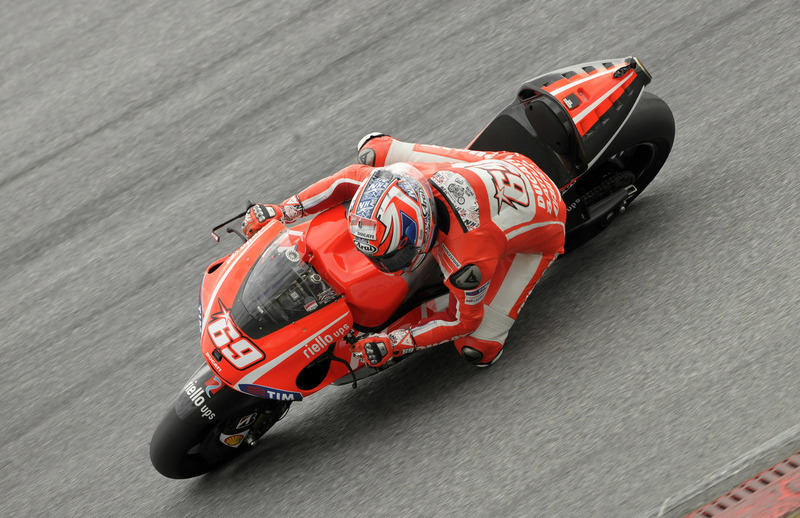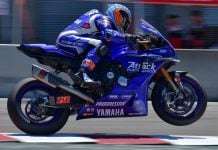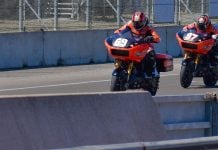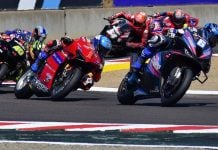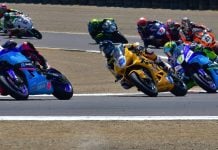2013 RED BULL INDIANAPOLIS GP TELECONFERENCE Nicky Hayden, March 14, 2013 MODERATOR: Good afternoon, everyone, and welcome to the Red Bull Indianapolis GP teleconference. Our guest today is 2006 World Champion Nicky Hayden. Nicky is from Owensboro, Kentucky, and is entering his 11th season of MotoGP, and he is starting his fifth consecutive season with the iconic Ducati team. Nicky, thanks for joining us today. NICKY HAYDEN: All right, thanks for having me. MODERATOR: Nicky, you guys have tested already twice in Sepang and you made some really good progress it seemed like in the second test. The bike seemed to come alive and you got closer to the pace set by the Honda’s and the Yamaha’s. Was there a real breakthrough or was there a evolution in the GP13? HAYDEN: Well, unfortunately I would say there wasn’t a huge breakthrough and it wasn’t quite that dramatic. It is true that we definitely reduced the gap to the front on some things. The track probably wasn’t as good for the second test, there was a lot of rain during the night and a lot of guys wasn’t as fast, and me and Dovi were quicker than the first test and reduced the gap to two seconds to 1.5 or 1.4 or something. It still is a lot. It is clear that we still have a lot of work to do, but we left there feeling a little bit more positive with some of the new things that we tested. It was stuff that we tried, we kind of hit on a couple things, so it was nice to find direction. If I am honest, the flight home after the first test was pretty rough. MODERATOR: New management this year, new ownership of the team with Audi coming in and buying Ducati and Bernhard Gobmeier running the team. Is there a distinct difference with the way the team has been ran in the past and if so, what is the most noticeable change with the new faces? HAYDEN: No, I would say inside the team there is not huge changes. Most of my core guys are pretty much the same. A lot of the same engineers that we have had and of course on Dovi’s side there are a lot of new faces. But for me there hasn’t been too much change in that regard. Of course, a new management style and a little bit of a different approach, but I would say they haven’t come in and turned things upside down at the moment. If you see some different things and different ways of working at the moment, no huge changes. I still feel pretty comfortable and not too much to adjust and the bike at the moment is still last year’s bike there hasn’t been a lot of changes from the new management just yet. Q: Hey there Nick, on my other screen right now I am watching Daytona live timing and scoring. I am guessing you may be down there or not. I just want to as Qatar as a race to you, do you kind of feel like it is the odd man out? Like Daytona here in the U.S. with the big gap. HAYDEN: Not particularly. I was watching Daytona a bit on and off today, too. But no I am not there, no. Not really, I don’t think there is a big gap. I think they have a two months off after Daytona and we have a week off and then the season picks up straight away from there. It feels odd out because it is a night race and it is the only night race of the year. I like the night race. I am glad that not every race is a night race but for the first race of the year it is really cool. We pretty well have to go racing right after Qatar. From there we have one week off, and then we go racing from there. Then Austin, then one week off then Jerez then things really pick up in Europe. Q: Speaking of the Austin race, there have been guys testing there the last few days and there are still guys running around there right now. Is that a track that you are looking forward to? Have you been following them there, as well? HAYDEN: Yes. I was obviously looking forward to it. I love going to new tracks for the first time, and I love the challenge. I was watching a lot of Tuesday, I was flying home from Germany and I had a four-hour layover in Chicago and I was killing time and reading up on what the guys had to say about the track. It was frustrating. Obviously I hated not being there and I hated giving those guys a big head start. But I was reading some of the comments and checking out some of the pictures from the track. Q: My question is and you are one of the few guys that can answer it. How much have Moto Grand Prix bikes changed from the first bikes 990 that you rode through the bikes you ridden up to the 1000cc Ducati today? HAYDEN: There have definitely been some changes. I would say the biggest changes have been with the electronics. I would say yearly those electronics can change greatly with the amount of changes and things. I would say 800 was a big change, small changes and the electronics have really made a lot of steps and the tires. There the tires were such a big part of finding the right tire, when you had a lot options. One race weekend with the single-tire rule changed the way you went about the weekend. You had your qualifying tires and many compounds front and rear. I would say there wasn’t probably wasn’t as many options with the bike. A lot of times during the weekend you were testing tires trying to find the right tire for the weekend because tires make a huge difference where you can really make or break your race. Where now we normally have two choices. We have a little bit shorter session which probably are justified because less changes now and it is probably more about dialing in the electronics. Q: And how much of an issue, how much of a challenge for the team has it been to go from down to 21 liters and now 20 liters and does this change of you what they ask as a rider? HAYDEN: Well, I think you would ask the engineers that, of course. I think it makes a difference. I think for me sometimes, I think how does a liter of fuel make that kind of a difference? But it does and really over a race distance makes a big difference. Last year with the 1000 we didn’t have too big of issues with the fuel and it really wasn’t a big part of it. With a couple of tracks that were a bit thirsty. Obviously, Japan was the one that was probably the thirstiest and Malaysia used to be until they took a lap off the race a couple of years ago. On 800, I would say the fuel really changed the game a bit. Those things, to really keep the bike and the power and to go off smooth was more tricky, and there were times as a rider we have had to change some things. I remember one time on Saturday nights, realizing that we have to make a big change or we aren’t going to finish the race. There were times we had to change the transmission to make it longer to make less RPM’s to save a bit of fuel and they have all kinds of little tricks, and it all adds up. Little grams of fuel and I mean on corner entry, you don’t realize to help the bike get into the corner and less rear wheel locking actually uses fuel for that. There would be times you have to use that and if it was really dramatic a couple of times, you would have to use a different gear in a different corner. Use third gear instead of second. That hasn’t been much of an issue lately, but there was definitely a time where you lost a lot of sleep over just fuel consumption. Q: Nick, what can you do now as essentially as a lead rider in your team to influence direction and I guess in the new organization do you feel like you are being listened to? HAYDEN: Yes, I do feel listened to. I can’t really say that I felt that in the past. Obviously with Valentino as a teammate, he got paid a lot of money, so of course it was clear is the more the number one. But I have never really had that problem with Ducati. As far as being listened to, it is important to go fast and you have clear feedback and be consistent. The worst thing for engineers is to if you want to lose their faith and confidence and be all over the board. You know, one minute say this and the next minute say that. Just try to be consistent with your feedback and tell them exactly what you feel and what you think. And don’t make anything up or don’t dream anything up and don’t lead them off and hope that it matches up with the data. Q: Dovi as your teammate. Quite a bit difference personality from Valentino. You obviously had a test at Sepang, and I think you have had a couple of independent tests. HAYDEN: Yes, at the moment everything has went really smooth. I have had no issues. I didn’t have any issues with Valentino at all. We have kept in touch and being teammates, and I definitely enjoyed being teammates with him. There were some benefits to it, and there were some negatives. With Dovi so far as a rider, I have a lot of respect for him. He is a great racer, which I respect, and it seems like a lot of our comments and issues are a lot of the same. Which is also really good, I mean for engineers do have one line to follow is also really good. Instead of having completely different comments and we were just in Germany for a couple of days doing a PR event and got a change to probably I would say I got to know him a bit more. And he doesn’t come with a lot of baggage. With him pretty much what you see is what you get and not a lot of typically teammate things. At the moment pretty just normal guy who pretty much just loves riding his bike and we have a few common interests now, you know, it is Supercross season. And we both talking about that, and he stays up watching the races in Europe and at the moment there have been no issues. Q: As an offshoot to Jim’s questions, in the last two years with Valentino as a teammate every single aspect of the bike was under a microscope, a media microscope because of Valentino on the team and because his well-publicized move to Ducati. Is it a little bit easier this year to develop the bike? Are you working a little bit under the radar because you don’t have the most popular guy in the sport on the team? HAYDEN: Well, I really feel like we need to move on past the two years with Valentino and we didn’t get the results that we wanted. Some of it there was a lot of pressure on the teams and the engineers and at times maybe we tried too hard and tried to make progress too quick. Probably maybe even took a few steps backward without even making any real progress. But then again, it had a lot of benefits. When he talked, people listened, and he did get stuff done in a hurry. So I would say it went both ways with us. Q: We have the 12 factory bikes out there. Each factory with two factory bikes and satellite bikes and then we have the gap to the CRT’s. Nicky, what is your opinion of what the CRT’s have been able to do and the whole initiative to use the CRT’s in the first place? HAYDEN: Personally, in an ideal world it would be 24 prototype bikes. That’s as a race fan what we would like to see. But I think the CRT had definitely had some good things to it. It has gotten more bikes on the grid and gotten some more faces out there. Of course, they are teams with smaller teams with smaller budgets. I am not a huge fan of the podium deal, but it looks like in the future it is building up some teams and giving some more people jobs. And unfortunately we are in a recession and we are in an economic crisis and it is expensive to go racing. It has in that area worked out the plan, so hopefully it keeps going. But ideally I would rather see 24 prototype bikes on the grid and everyone a little bit closer. I mean it looks like things might be a little bit closer this year they have some softer tires than the prototypes and a few things that should help them brings the bikes closer. Q: Well, I would be in a lot of trouble in Spain if I didn’t ask this question. Everybody wants to know what your take on Marc Marquez and his first performance as a factory rider? HAYDEN: Well, it is impressive You don’t need me to tell you that. I don’t think anybody doubted that he was going to be fast, I mean the 125, Moto2, whatever. When you are fast, you are fast. I would say to be quite this quick and even so consistently quick this early it wasn’t expected and for some of us riders we aren’t so pumped on it. Honestly, I think we wanted to give him a little more time, and he is going to be exciting for the sport. He rides very hard and he is very hungry. You know, if he can stay healthy, he is really going to shake things up this season. So he is been very, very impressive and very fast, which is a bit of his own style. And he could be a game-changer to MotoGP and all of road racing. Q: We have three rounds this year of MotoGP in the United States. We have Austin next month and Laguna Seca and July and of course the Red Bull Indianapolis GP on August 16-18 here in Indianapolis. There is only one country in the series that has more rounds than the States. What does that say about America’s place in MotoGP to now have three races here in the States? HAYDEN: I love it. I truly appreciate it. When I first went to MotoGP in 2003, there were no races in America. The closest race was in Brazil. So I appreciate it and I think the good thing for us is that it is three different races and three very different places. So I think that is really good for the fans. You know, it is not the same, you know, Laguna has its own character and charm and it’s the only race without Moto2 and Moto3. And it is the only change for the AMA guys to ride with us. Austin is new, and of course Indy for me is my home race. It is at the Brickyard, and it’s right there in the Midwest and it has so much population around it. So it is great, and I hope the American fans can come out and support it. I hope all three races are a huge success. We can see America is a very important market. When I won the World Championship, it was hard to really be a real American championship without a round in America. But now, we have three and we need to do our part and appreciate it and support it. Hopefully they can feed off each other and make them all better. Q: How much integration is there this year with the Pramac team with Ben (Spies) and Andrea (Iannone)? Is it more than years past or is it truly a four-bike effort or did you work with that team at the Sepang test? HAYDEN: Well, I would say even in years past Ducati has been pretty close with the satellite team and the engineers are the same. This year all four bikes are full factory bikes and full factory efforts. We need that. So, to make the progress the more data and feedback the more different styles it is going to be important and useful for the engineers it is going to be important. I mean it is important to group that data all together and with less testing we have now more riders that we have now hopefully with more riders. I know me and Dovi do and I know Ben had a few different comments. Andrea is also very unique for them as he really knows nothing about MotoGP. Everything he says should be really raw and unique, and I think Dovi and Ben have really great experience coming from Yamaha. And even before that, Dovi did a couple of seasons at Honda. Then me I had reference at Ducati, and my data can be carried over from years past. And they have a great group and a good lineup of some different riders and coming in with some different background. So we can cover all areas. We know that we have a lot of work to do, but everybody is up to the challenge. I certainly believe in Ducati and our sponsors, and I know it isn’t going to be easy at the beginning of the season. Especially with the gap to the front is too big, and time right now isn’t on our side, which is unfortunate. But there is a lot of good stuff in the pipeline, and I hope we can make progress quick and have a successful season. Q: Nicky to you without throwing him under the bus, what do you feel is the current failing of the 2013 bike? I am going to assume it is the front-end feel? HAYDEN: That is something that we have been fighting for a couple of years now so we need to solve that before we can look at the other stuff. I mean we have a couple of different little issues. The front-end feel, front end turning it is more or less I would say goes under the same category, and I would say goes under the same issues. Q: So you guys got handed new Bridgestones in Sepang and probably were given a plethora to choose from. Did you find anything new there or is it still the same working through the issues? HAYDEN: The Bridgestone tire at the moment hasn’t really changed a lot for next year. There is some stuff in the harder solution, but it wasn’t really the right compound for Malaysia and those conditions. But we hope this year we will be able to use the harder compound more. But last year there were very few occasions at tracks where we used the harder compound and this year hopefully they have worked to make it a little bit closer. To make it where they will work a little bit better. Bridgestone we know makes great tires and for some ways we know that is one thing that we don’t have to worry about and spend too much time developing the tires, and we know they will bring us good tires and we have to make the bike work around them. Q: Nicky, when I first started covering Grand Prix, which was a long time ago, the Italians and the British were the guys to beat. And then came the Americans. The guys you grew up watching, the guys from ’78 through Kevin Schwantz and then you and Junior (Kenny Roberts Jr.) each had sporadic titles in there. The Spanish TV stations that I would for would consider a good day if all three riders on all three classes on podium finishes. And that certainly is possible going into this next season. Where did America start to fall behind and what does the United States needs to do to get Americans back on the podium again? HAYDEN: Well, it is true. Definitely the Spanish on some days, the amount of podiums would take home were incredible. You would probably know better than me where things went off track in the early 80s and the 90s when all the dirt trackers made the transitions to 500. They were really suited to those with the amount of power and their sliding which I think dirt track was the best training for that. Where now the sport has changed a lot and with the electronics and tires, the way the four strokes are ridden. In Spain, I would say the main thing they are doing so good is starting the kids so young. It doesn’t matter if you are golfing, riding motorcycles or want to be a cook. It is a young man’s game. The younger you start, the better you are. I see it in Italy but mainly in Spain. These academies and schools where they are starting these kids on road racing on real bikes and real competition at a young age. If American wants to catch up, that is what America is going to have to do. The age limit in America is a little different. It makes it a little bit harder, and it is a bit later to get on a bigger bike. We need to follow those next steps and get some kids in a competitive series earlier, like the Rookies Cup in Europe and it has certainly helped start young riders and these academies.
Ducati’s Nicky Hayden: There Is A Lot Of Good Stuff In The Pipeline
Ducati’s Nicky Hayden: There Is A Lot Of Good Stuff In The Pipeline
© 2013, Roadracing World Publishing, Inc.
